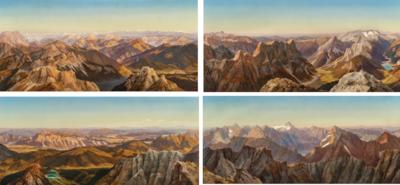Markus Pernhart
(Untermieger 1824–1871 Klagenfurt)
A Panorama from the Mangart in the Julian Alps, oil on canvas, 66 x 146 cm each, framed (4)
Provenance:
Purchased directly from the artist;
Private Collection, Austria, for three generations.
Compare:
Arnulf Rohsmann, Markus Pernhart. Die Aneignung von Landschaft und Geschichte, Klagenfurt 1992, pp. 355–365.
Markus Pernhart is considered the leading Carinthian landscape painter of his time and was a "pioneer" in more ways than one. He began his early training with the Biedermeier painters Eduard Ritter von Moro and Franz Steinfeld before completing his artistic studies at the Academy of Fine Arts in Munich. He left behind an extensive oeuvre focused on the Carinthian cultural and alpine landscape and positioned himself at the crossroads of exploratory art, painting and science. He approached his panoramas with a great spirit of exploration and transcended contemporary conventions in landscape painting. He attached great importance to geographical accuracy in his works, which he achieved with the help of a diopter-bussole, a special precision compass. For Pernhart, painting and exploring the alpine mountain world went hand in hand and he developed what were termed panoramic views from the late 1850s onwards in order to translate the overwhelming effect of the wide views from the mountain summits into painting: a four-part, large-format picture series that gives the viewers the feeling of standing at the summit themselves. Pernhart achieved fame beyond Carinthia with his monumental Grossglockner panorama (today in possession of the Carinthian Provincial Museum), which he created between 1857 and 1859, and exhibited in Klagenfurt and Vienna in 1860 and in Graz in 1862. He subsequently produced about 20 to 25 other panoramas of various mountain peaks, including a panorama of the Koralpe, the Dobratsch, the Magdalensberg, the Luschariberg, the Hochwab, the Saualpe, the Sternberg, the Villacher-Alpe, the Schöckl and the present four-part series of pictures from the top of the fourth highest peak in the Julian Alps on the border between Slovenia and Italy, the Mangart.
This panorama was created between 1860 and 1869, as reported in the Laibacher Tagblatt of 13 May 1869 „Tomorrow, the painter Pernhart [...] will inaugurate an exhibition of his latest works in the Redoutensaal: Panorama from the top of the Mangart, Panorama from the Luschariberg and View of Lake Zirknitz". This series must therefore have been completed in 1869 and planned from 1860 onwards. In a contemporary press release of the Klagenfurter Zeitung on 12 October 1860, a mountaineer enthusiastically reports his encounter with the bold alpinist and well-known artist: "[...] then a sprightly man entered, cheerful and laughing. It was Pernhart, who had taken pleasure in imitating the gurgling sounds of a half-wit. I was delighted to make the artist's acquaintance and learned from him that he climbs the Mangart several times a week to take a circular painting similar to the one of the Grossglockner." Although for Pernhart the exact reproduction of nature was considered essential, he was nevertheless influenced by the landscape painting of his time and the balanced composition and painterly quality of his works were important to him. He himself explains that the peaks depicted in his panoramas were not chosen by chance: “When asked why he did not depict it from Triglav, he said that the panorama from Mangart was more picturesque because a higher mountain range, Triglav, provided the backdrop.” (Klagenfurter Zeitung, 12 October 1860). Thus he always found new, spectacular vantage points that astonished his contemporaries.
Parallel to the increasingly popular alpinism, a bustling tourist trade developed in the 19th century, which spread the popularity of the majestic mountains far and wide and increased the demand for Pernhart´s pictures. The geographical accuracy of the panoramic view offered here continues to impress today and it documents an entire stretch of land before the building boom of the 20th century.
The view towards the northwest shows the splendour of the Grossglockner group with the towering peak of the Grossglockner in the distance; further north lie the upper and lower Weissenfelsensee lakes, behind them the Gailtal valley and the Dobratsch massif. Towards the north-east, the wide lake landscape of Carinthia with Lake Ossiach and, further to the north-east, Lake Wörthersee. To the east on the horizon are the Karawank Mountains and to the southeast rises the wild Triglav group with its striking mountain peak, Jalovec. Towards the south are the peaks of the Julian Alps with their countless towns and villages and, in the distance, the bay of the Adriatic Sea. In the south-western foreground lies Lake Predil and to the west the Friuli mountains and the Dolomites.
Esperta: Johanna Plank, MA
 Johanna Plank, MA
Johanna Plank, MA
+43-1-515 60-501
johanna.plank@dorotheum.at
24.10.2023 - 18:00
- Prezzo realizzato: **
-
EUR 208.000,-
- Stima:
-
EUR 160.000,- a EUR 220.000,-
Markus Pernhart
(Untermieger 1824–1871 Klagenfurt)
A Panorama from the Mangart in the Julian Alps, oil on canvas, 66 x 146 cm each, framed (4)
Provenance:
Purchased directly from the artist;
Private Collection, Austria, for three generations.
Compare:
Arnulf Rohsmann, Markus Pernhart. Die Aneignung von Landschaft und Geschichte, Klagenfurt 1992, pp. 355–365.
Markus Pernhart is considered the leading Carinthian landscape painter of his time and was a "pioneer" in more ways than one. He began his early training with the Biedermeier painters Eduard Ritter von Moro and Franz Steinfeld before completing his artistic studies at the Academy of Fine Arts in Munich. He left behind an extensive oeuvre focused on the Carinthian cultural and alpine landscape and positioned himself at the crossroads of exploratory art, painting and science. He approached his panoramas with a great spirit of exploration and transcended contemporary conventions in landscape painting. He attached great importance to geographical accuracy in his works, which he achieved with the help of a diopter-bussole, a special precision compass. For Pernhart, painting and exploring the alpine mountain world went hand in hand and he developed what were termed panoramic views from the late 1850s onwards in order to translate the overwhelming effect of the wide views from the mountain summits into painting: a four-part, large-format picture series that gives the viewers the feeling of standing at the summit themselves. Pernhart achieved fame beyond Carinthia with his monumental Grossglockner panorama (today in possession of the Carinthian Provincial Museum), which he created between 1857 and 1859, and exhibited in Klagenfurt and Vienna in 1860 and in Graz in 1862. He subsequently produced about 20 to 25 other panoramas of various mountain peaks, including a panorama of the Koralpe, the Dobratsch, the Magdalensberg, the Luschariberg, the Hochwab, the Saualpe, the Sternberg, the Villacher-Alpe, the Schöckl and the present four-part series of pictures from the top of the fourth highest peak in the Julian Alps on the border between Slovenia and Italy, the Mangart.
This panorama was created between 1860 and 1869, as reported in the Laibacher Tagblatt of 13 May 1869 „Tomorrow, the painter Pernhart [...] will inaugurate an exhibition of his latest works in the Redoutensaal: Panorama from the top of the Mangart, Panorama from the Luschariberg and View of Lake Zirknitz". This series must therefore have been completed in 1869 and planned from 1860 onwards. In a contemporary press release of the Klagenfurter Zeitung on 12 October 1860, a mountaineer enthusiastically reports his encounter with the bold alpinist and well-known artist: "[...] then a sprightly man entered, cheerful and laughing. It was Pernhart, who had taken pleasure in imitating the gurgling sounds of a half-wit. I was delighted to make the artist's acquaintance and learned from him that he climbs the Mangart several times a week to take a circular painting similar to the one of the Grossglockner." Although for Pernhart the exact reproduction of nature was considered essential, he was nevertheless influenced by the landscape painting of his time and the balanced composition and painterly quality of his works were important to him. He himself explains that the peaks depicted in his panoramas were not chosen by chance: “When asked why he did not depict it from Triglav, he said that the panorama from Mangart was more picturesque because a higher mountain range, Triglav, provided the backdrop.” (Klagenfurter Zeitung, 12 October 1860). Thus he always found new, spectacular vantage points that astonished his contemporaries.
Parallel to the increasingly popular alpinism, a bustling tourist trade developed in the 19th century, which spread the popularity of the majestic mountains far and wide and increased the demand for Pernhart´s pictures. The geographical accuracy of the panoramic view offered here continues to impress today and it documents an entire stretch of land before the building boom of the 20th century.
The view towards the northwest shows the splendour of the Grossglockner group with the towering peak of the Grossglockner in the distance; further north lie the upper and lower Weissenfelsensee lakes, behind them the Gailtal valley and the Dobratsch massif. Towards the north-east, the wide lake landscape of Carinthia with Lake Ossiach and, further to the north-east, Lake Wörthersee. To the east on the horizon are the Karawank Mountains and to the southeast rises the wild Triglav group with its striking mountain peak, Jalovec. Towards the south are the peaks of the Julian Alps with their countless towns and villages and, in the distance, the bay of the Adriatic Sea. In the south-western foreground lies Lake Predil and to the west the Friuli mountains and the Dolomites.
Esperta: Johanna Plank, MA
 Johanna Plank, MA
Johanna Plank, MA
+43-1-515 60-501
johanna.plank@dorotheum.at
|
Hotline dell'acquirente
lun-ven: 10.00 - 17.00
kundendienst@dorotheum.at +43 1 515 60 200 |
| Asta: | Dipinti dell’Ottocento |
| Tipo d'asta: | Asta in sala con Live Bidding |
| Data: | 24.10.2023 - 18:00 |
| Luogo dell'asta: | Wien | Palais Dorotheum |
| Esposizione: | 14.10. - 24.10.2023 |
** Prezzo d'acquisto comprensivo di tassa di vendita e IVA
Non è più possibile effettuare un ordine di acquisto su Internet. L'asta è in preparazione o è già stata eseguita.

